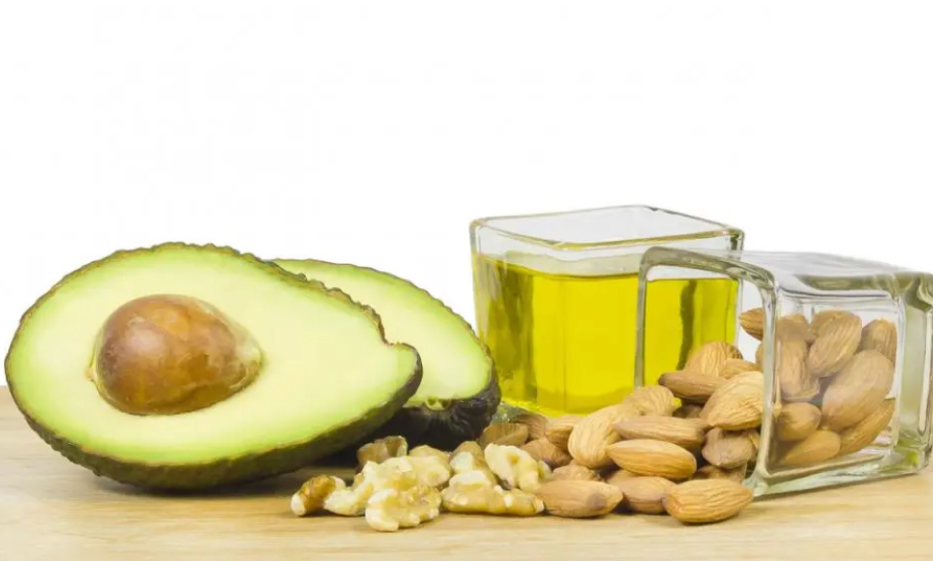Nutrition & Health Info Sheets contain up-to-date information about nutrition, health, and food. They are provided in two different formats for consumer and professional users. These resources are produced by Dr. Rachel Scherr and her research staff. Produced by Lyndsey D. Ruiz, BS, DTR, Sheri Zidenberg-Cherr, PhD, Center for Nutrition in Schools, Department of Nutrition, University of California, Davis, 2016.
What are fats?
Fats are a subset of a class of nutrients called lipids, which also include phospholipids and sterols. Usually when people refer to fats and oils, they are speaking of triglycerides, the most common forms of fat in the diet. Triglycerides come in many sizes and several varieties, but they all share a common structure: a backbone of glycerol to which three fatty acids are attached. While all glycerol molecules are alike, the fatty acids may vary in two ways: length and degree of saturation.
Jump To
- What are fatty acids?
- What functions do fats serve?
- What are trans fatty acids?
- How much fat should be included in your diet?
- When does too much fat become a problem?
- How is fat intake calculated?
- What are some ways to control fat intake?
- What are some food sources for different kinds of fats?
- What is the total fat, saturated fat, and unsaturated fat content of some common foods? (17)

Monounsaturated fatty acids
Monounsaturated fatty acids have one double bond in their structure. These can be found in plant sources such as nuts and vegetable oils like olive, canola, and sunflower oils. They are liquid at room temperature (1).

Polyunsaturated fatty acids
Polyunsaturated fatty acids have two or more double bonds in their structure. They are usually liquid at room temperature. Based on the position of the first double bond, polyunsaturated fatty acids can be either omega-6 or omega-3 fatty acids. Sources of omega-6 fatty acids include nuts and liquid vegetable oils such as soybean, corn, and safflower oils. Sources of omega-3 fatty acids include fish, walnuts, flaxseed, soybean oil, and canola oil (1). Three types of fatty acids form the basic chemical units in fat: saturated, monounsaturated, and polyunsaturated. All dietary triglycerides are made up of a mixture of these fatty acid types.
Saturated fatty acids
Saturated fatty acids do not have double bonds in there structure. These are concentrated in fats from meat and dairy products. Saturated fatty acids are also found in medium-chain fatty acids, such as tropical oils like coconut, palm, and palm kernel oils. Fats that are high in saturated fatty acids are generally solid at room temperature (1).
What functions do fats serve?
Triglycerides are mainly responsible for storing energy and insulating the body and organs. They also transport vitamins that are fat-soluble and contribute to taste and feeling full after eating a meal (4).
Fat can be found in various forms in the diet and each form can serve a different purpose. Essential fatty acids are omega-3 and omega-6 fatty acids that the human body is not able to create in adequate amounts, and must come from food sources (1). Alpha-linolenic acid (omega-3) and linoleic acid (omega-6) are the two essential fatty acids; they play a key role in the immune system, vision, and cell structure. Good food sources for these essential fatty acids include vegetable oils that can be found in mayonnaise and salad dressings. Other omega-3 fatty acids are eicosapentaenoic acid (EPA) and docosahexaenoic acid (DHA) which are important for the immune system, cellular processes, and neural responses (1,4). These fatty acids are abundant in fish such as salmon, halibut, and trout.
What are trans fatty acids?
Trans fatty acids are the product of hydrogenating oils, a process that converts liquid fat to solid fat. This method has been used by many food manufacturers because it extends the shelf life of foods, increases resistance to rancidity, and is fairly inexpensive. Trans fatty acids also occur naturally in some animal products (1).
Studies have found that trans fats raise low density lipoprotein cholesterol (LDL-C) and total cholesterol and suggest a correlation between cardiovascular disease and trans fat intake (1). Due to concern about this correlation, the Food and Drug Administration (FDA) requires information about the trans fat content of foods on nutrition food labels. Since the effective date of this requirement, January 1, 2006, average consumption of industrially-produced trans fat has significantly decreased from 3 to about 0.6 percent of total calorie intake in the United States (3).
When does too much fat become a problem?
A substantial rise in the prevalence of obesity among children and adults in the United States has been observed (6). National statistics show that approximately 30 percent of children and adolescents and over 68 percent of adults are considered overweight or obese (6). This trend contributes to the population being at greater risk of developing chronic conditions such as type II diabetes and cardiovascular disease (1). Factors contributing to obesity are large portion sizes, low intakes of nutrient-dense foods, and inadequate exercise (1). Furthermore some nutrients, such as saturated fat, are a concern for overconsumption (1).
What is the relation between fat and cardiovascular disease?
Cardiovascular disease (CVD) is a public health concern because an estimated 83.6 million, or 1 in 3, Americans have at least one type of CVD (7). Risk factors for CVD include inactivity, high serum triglycerides and cholesterol, and overweight and obesity (8). While some fat is essential in our diet, it is recommended to monitor fat consumption (1). On average, about 36 percent of daily calories comes from total fat and almost 12 percent from saturated fat in American diets (1,9). Although saturated fat consumption has shown no significant association with incidence of CVD, replacing saturated fat with unsaturated fat, particularly polyunsaturated fat, has been associated with reduced risk by lowering triglycerides, total cholesterol, and LDL-C in the blood (7,8). A low cholesterol diet was previously believed to lower serum cholesterol, however studies have found no relationship between consumption of dietary cholesterol and levels of serum cholesterol (1,8).
Dietary patterns that have shown positive results in reducing risk of CVD are rich in vegetables, fruit, whole grains, low- and non-fat dairy, and seafood, low in red/processed meats, and include regular intake of nuts and legumes (8). Avoiding partially hydrogenated oils containing trans fat is also recommended (1). This diet can be achieved and tailored to individual needs through multiple dietary patterns (1).
What is the relation between fat and cancer?
There is some evidence that diets higher in vegetables, fruit, whole grains, lean meats, and seafood, and lower in red/processed meats and saturated fatty acids are associated with a lower risk of certain cancers, especially colorectal and breast (1). However, the National Cancer Institute does not support any diet for prevention of breast, colorectal, lung, or prostate cancers (10-13). Studies are currently being conducted to determine if different diet modifications can help prevent certain cancers (10-13). There is some emerging research of medium chain fatty acids inhibiting growth of certain human cancer cells (14). However, studies have only been conducted in vitro so conclusions on potential effective in vivo cannot be drawn until further research is conducted (14). Thus, the best advice is maintaining a healthy body weight and getting regular physical activity (1).
The preparation of food is also of importance. Deep-frying foods or charbroiling them until they have a burned surface may pose a risk to the consumer since this process results in development of potential carcinogens through fat oxidization (15)
What is the relation between fat and mental health?
Studies for dietary patterns to aid in mental health disorders are very recent and still developing evidence (1). Omega-3 fatty acids DHA and EPA are the most studied in relation to neural health (1). Some studies have found DHA to aid in neural signaling speed and EPA to have antidepressive properties when used in combination with other treatments (1,16). Due to enough strong evidence of favorable results, the American Psychological Association uses supplementation with DHA and EPA for major depressive disorders (16).
How much fat should be included in your diet?
The 2015-2020 Dietary Guidelines for Americans recommends limiting total fat to 20 to 35 percent of total daily calories and saturated fat to no more than 10 percent of total daily calories (1,2). According to the most recent report from the Institute of Medicine’s Food and Nutrition Board on Acceptable Macronutrient Distribution Range for Fat, the suggested goal is to maintain a total dietary fat intake of 20 to 35 percent for adults, 30 to 40 percent for children ages 1 to 3, and 25 to 35 percent for children ages 4 to 18 (5).
How is fat intake calculated?
You can determine the number of grams of fat that provide 30 percent of calories in the daily diet as follows:
Multiply the total calories for one day by 0.30 to get the recommended amount of calories from fat per day. (Example: 1,800 calories x 0.30 = 540 calories from fat. So if you consume 1,800 calories per day, about 540 calories should come from fat.)
Divide calories from fat per day by 9 (each gram of fat contains 9 calories) to get grams of fat recommended per day. (Example: 540 calories from fat divided by 9 = 60 grams of fat.)

What are some ways to control fat intake?
The 2015-2020 Dietary Guidelines for Americans recommends taking a food-based, total diet approach to meet recommendations (1,2). There are several strategies to help reduce fat consumption including smaller portions and recipe modifications (1).
Here are a few simple dietary suggestions to accomplish this goal:
- Consume 7 to 9 servings of fruits and vegetables each day to partially replace fatty foods and promote satiety.
- Add a mixture of whole grain products to the diet.
- Replace fatty meats with skinless chicken, fish, or other lean meats, and drink fat-free or low-fat milk instead of whole milk.
- Include a wide variety of food and beverages.
Diets very low in fat are generally not recommended because fat is often replaced with refined carbohydrates which has generally been associated with dyslipidemia through hypertriglyceridemia and low high density lipoprotein cholesterol (HDL-C) concentrations (1,8). Dietary fat consumption should be balanced instead of reducing total fat (1).
What are some food sources for different kinds of fats?

Polyunsaturated fats
Safflower, sunflower, corn

Omega-3 fatty acids
Fish, walnuts, flaxseed, and canola oil

Omega-6 fatty acids
Salad dressings, soybean oil, and nuts

Trans fatty acids
Packaged baked goods, chips
What is the total fat, saturated fat, and unsaturated fat content of some common foods? (17)
References
- US Department of Agriculture and US Department of Health and Human Services. 2015. Scientific Report of the 2015 Dietary Guidelines Advisory Committee. Dietary Guidelines for American Website, http://health.gov/dietaryguidelines/2015-scientific-report/PDFs/Scientific-Report-of-the-2015-Dietary-Guidelines-Advisory-Committee.pdf.
- US Department of Health and Human Services and US Department of Agriculture. 2015-2020 Dietary Guidelines for Americans. 8th Edition. December 2015. Available at http://health.gov/dietaryguidelines/2015/guidelines/.
- Doell D, Folmer D, Lee H, Honigfort M, Carberry S. Updated estimate of trans fat intake by the US population. Food Addit Contam Part A Chem Anal Control Expo Risk Asses. 2012; 29 (6): 861-874.
- Nelms, MN, Sucher, KP, Lacey, K. Nutrition Therapy and Pathophysiology. 3rd ed. Boston, MA: Cengage Learning; 2014.
- Institute of Medicine, Dietary Reference Intakes for Energy, Carbohydrate, Fiber, Fat, Fatty Acids, Cholesterol, Protein, and Amino Acids (Macronutrients); 2002; National Academy Press; www.nap.edu.
- Ogden CL, Carroll MD, Kit BK, Flegal KM. Prevalence of childhood and adult obesity in the united states, 2011-2012. JAMA. 2014; 311(8): 806-814.
- Go AS, Mozaffarian D, Roger VL, Benjamin EJ, Berry JD, Blaha MJ, et al. Heart disease and stroke statistics--2014 update: a report from the American Heart Association. Circulation. 2014;129(3):e28-e292. http://www.ncbi.nlm.nih.gov/pubmed/24352519.
- Eckel RH, Jakicic JM, Ard JD, de Jesus JM, Houston Miller N, Hubbard VS, et al. 2013 AHA/ACC guideline on lifestyle management to reduce cardiovascular risk: a report of the American College of Cardiology/American Heart Association Task Force on Practice Guidelines. Circulation. 2014;129(25 Suppl 2):S76-99.
- U.S. Department of Agriculture, Agricultural Research Service. 2014. Nutrient Intakes from Food and Beverages: Mean Amounts Consumed per Individual, by Gender and Age, What We Eat in America, NHANES 2011-2012.
- National Cancer Institute: PDQ® Breast Cancer Prevention. http://www.cancer.gov/types/breast/patient/breast-prevention-pdq. Updated October 22, 2015. Accessed December 30, 2015.
- National Cancer Institute: PDQ® Colorectal Cancer Prevention. http://www.cancer.gov/types/colorectal/patient/colorectal-prevention-pdq. Updated July 23, 2015. Accessed December 30, 2015.
- National Cancer Institute: PDQ® Lung Cancer Prevention. Updated November 4, 2015. Accessed December 30, 2015.
- National Cancer Institute: PDQ® Prostate Cancer Prevention. http://www.cancer.gov/types/prostate/patient/prostate-prevention-pdq. Updated July 31, 2015. Accessed December 30, 2015.
- Narayanan A, Baskaran SA, Amalaradjou MAR, Venkitanarayanan K. Anticarcinogenic properties of medium chain fatty acids on human colorectal, skin and breast cancer cells in vitro. Int J Mol Sci. 2015; 16(3): 5014-5027.
- Capuano E, Fogliano V. Acrylamide and 5-hydroxymethylfurfural (HMF): A review on metabolism, toxicity, occurrence in food and mitigation strategies. LWT-Food Science and Technology. 2015; 44(4): 793-810.
- Gelenberg AJ, Freeman MP, Markowitz JC, Rosenbaum JF, Thase ME, Trivedi MH, et al. Practice Guideline for the Treatment of Patients With Major Depressive Disorder, Third Edition. 2010. http://psychiatryonline.org/pb/assets/raw/sitewide/practice_guidelines/guidelines/mdd.pdf.
- National Nutrient Database for Standard Reference Release 28. United States Department of Agriculture Agricultural Research Service Website. http://ndb.nal.usda.gov/ndb/search. Accessed December 28, 2015.



